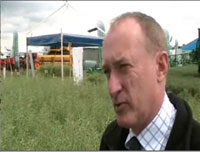VIDEO: Velcourt research nitrogen efficiency

Applying foliar sprays of suspensions of nitrifying bacteria could potentially reduce nitrogen applications by a third, if the technology can be proven to work, Keith Norman, technical director of Velcourt, said at Cereals 2011.
It was just one of three types of novel nitrogen fertilisers his firm are trialling this year to potentially reduce reliance on expensive inorganic nitrogen fertilisers, and improve nitrogen use efficiency.
“The bacteria are sprayed onto plants, impregnating the leaves and also getting washed down into the roots. They have the ability to nitrify atmospheric nitrogen into nitrate for the plants to use directly.”
That could be particularly useful this season, he suggested. “If ever there was a season where that could be a benefit, it is this season with the drought restricting uptake of nitrogen fertilisers.”
Two suspensions were being trialled, one from Cleveland Biotec, the other Twin-N produced by Mapleton International Limited, he said.
The manufacturers claim using the bacteria could reduce inorganic nitrogen fertiliser use by 30%. “If they are right, then bacterial suspensions could have the biggest payback of the different types of technologies we’re looking at.”
The firm is also trialling three slow-release nitrogen fertilisers. Koch Advanced nitrogen and Didin both work by inhibiting the urease enzyme in soils, which converts urea to ammonia.
Slowing down that reaction helped reduce volatilisation losses from the urea fertiliser, he explained.
“We’re also looking at coated urea prills, which provide a physical barrier to produce a slow-release product that trickle feeds nitrogen to the crop. In theory you can apply a large amount of nitrogen at the beginning of the season, and call it job done.”

